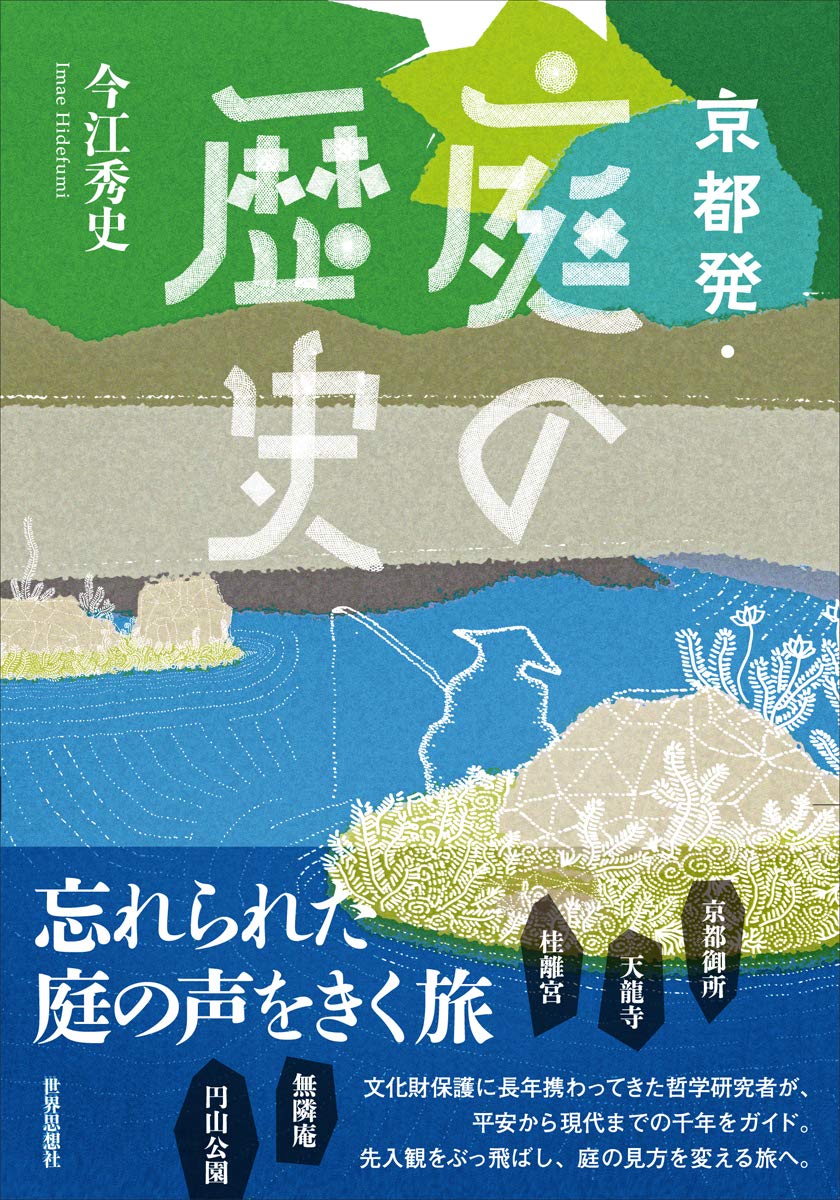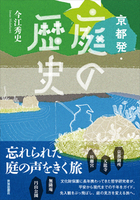- イベント
A History of Kyoto’s Gardens/发自京都·庭园的历史

A History of Kyoto’s Gardens
Hidefumi Imae
186 mm × 130 mm
232 pages
JPY 2400
ISBN 9784790717430
Pub date: July 2020
The author has overseen garden maintenance and management for many years as the Kyoto City Cultural Properties Protection Division’s only professional engineer specializing in gardens. Tracing 1,000 years of history of famous Kyoto sites, such as Tenryū-ji Temple and Nijō Castle, this book presents a new consideration of gardens with a focus on how they are used. A true view of gardens unavailable in guidebooks.
Reviews
“I was surprised by this book.” ―Toshiko Watanabe, poet
“The source of this book's charm and persuasiveness is the actual experience and concrete knowledge of the protection of cultural property gardens” ―Makoto Sato, ancient historian
“A garden may look like a natural form, but it is a place where people's desires and spirits are strongly expressed.” ―Junko Sakai, essayist
Table of Contents
Preface
Introduction: How elementary schools and the homes of Heian-era aristocrats are linked through time
Chapter 1: It isn’t a garden if it isn’t used: The Heian period
Chapter 2: Appearance comes to the forefront: The late Heian to Azuchi–Momoyama period
Chapter 3: A profusion of gardens: The Edo period
Chapter 4: Gardening becomes democratized: The modern era
Chapter 5: Those at the forefront of maintaining tradition: Today
Conclusion: The history and phenomenology of gardens
Afterword
Primary works cited
Index
Index of garden, architecture, and place names
Preface
I am one of the specialized technicians at the Kyoto City Cultural Properties Protection Division assigned to various fields of cultural properties. My main area of responsibility is “scenic spots” such as those at Arashiyama, the Sanbō-in at Daigo-ji Temple, and the Hōjō Garden at Ryōan-ji Temple. Aside from my work as a city official, I also conduct academic research on gardens, following the philosophy of “phenomenology.” I am what you might call a field researcher. This book is a guide to the history of gardens based on both my engineering work and my own research results.
In the Introduction, I start by presenting some terminology and four basic categories for gardens that have been used since the Heian period (794–1185). In Chapters 1 through 4, I trace the use of gardens from the Heian period to the modern era, while simultaneously extracting what it was that people sought from gardens in each period. Chapter 5 depicts the actual nature of contemporary garden work. The concluding chapter highlights the true nature of gardens through phenomenology, a philosophy born in nineteenth-century Germany that was the starting point for my ideas in this book.
I recommend this book for those who are interested in gardens and visit them on vacations, but who have not yet considered them in depth, or who have been unable to grasp their history from previous guides. I also hope those who work with or study gardens and architecture will take this as an opportunity for criticism and discussion. I hope it will also interest researchers in fields indirectly related to gardens, including art, archaeology, human geography, anthropology, and history, as well as those of phenomenology and other branches of philosophy that consider everyday life.
I believe that reading this book will completely change your view of not only gardens but also homes, allowing you to more systematically understand the relationship between gardens and architecture, as you are familiar with through your daily life. When visiting an old garden or building for sightseeing or study, it then will be easier to judge which parts are inherited from the past and which are new. You will see how even spaces in your home that may at first glance appear to be simply empty are actually “gardens” vibrant with meaning. I hope the result will be richer and more fulfilling experiences in everything from your daily commute to your travel destinations.
Keywords
Kyoto Imperial Palace, Tenryuji Temple, Katsura Imperial Villa, Shugakuin Imperial Villa, Murinan, Maruyama Park, Kinkakuji Temple, Ginkakuji Temple, Ryoanji Garden, Byodo-In Temple, Daikakuji Temple, Daigoji Temple, Daitokuji Temple, Honganji Temple, Nanzenji Temple, Nijo Castle
Media Coverage
Yomiuri Shimbun, Nikkei Shimbun, Mainichi Shimbun, Weekly Bunshun
Awards
16th Japanese Garden Society Award
Author Information
Born in Yamaguchi Prefecture in 1975 and raised in Kyoto City, Kyoto Prefecture. M.F.A., Kyoto University of Art and Design. Ph.D. from Graduate School of Human Sciences, Osaka University. Doctor of Human Science. Currently works for Kyoto City Hall.
Specializes in research on the history, mechanism, repair, maintenance, and artisanal language of gardens, as well as phenomenological qualitative research. He is the author of Dynasty Literature, Architecture, and Gardens (co-authored, Chikurinsha, 2007) and Kyoto Jissoin Monzeki (co-authored, Shibunkaku Shuppan, 2016).
发自京都·庭园的历史
今江秀史
186mm x132mm
232pages
JPY 2400
ISBN 9784790717430
Pub month: July 2020
作者是京都市文化遗产保护课唯一的庭园专业技师,多年来负责庭园的维护管理。以天龙寺、二条城等京都名胜为舞台,循迹千年历史,演绎着眼于庭园使用方法的全新庭园赏鉴法。通过本书,可领略到旅行指南上所看不到的真正庭园赏鉴法。
・目录
序言
序章 跨越时空联结的小学与平安时代贵族宅邸
第1章 无使用不庭园——平安时代
第2章 重视外观的开始——平安时代后期~安土桃山时代
第3章 百“庭”缭乱——江户时代
第4章 庭园建设的民主主义——近代
第5章 在传统继承最前线持续奋斗的人们——现代
终章 庭园的历史与现象学
结束语
主要参考文献
事项索引
庭园、建筑、地名索引
・序言
我是一名隶属于京都市文化遗产保护课并被分配到所属文化遗产领域的专业技术人员。我主要负责岚山、醍醐寺三宝院、龙安寺方丈庭园等“名胜”。除了正职工作以外,同时还在进行遵循“现象学”这一哲学的庭园学术研究,即所谓民间研究人员。本书为基于我的技术人员本职工作和个人研究成果所撰写的“庭园”历史指南。
首先,在序章中我对平安时代以来的庭园的基本四分区和术语进行了梳理。第1章到第4章,在追溯平安时代到近代的庭园的使用方法的同时,揭示了各时代的人们从庭园中寻求的意义。在第5章中描写了现代庭园工作的实际情况。终章则通过本书的思维原点——十九世纪诞生于德国的哲学“现象学”,刻画出庭园的本相。
我想把这本书推荐给对庭园感兴趣、旅行时会去造访但对深入了解有抵触情绪、以往未能从旅游指南了解到庭园历史的读者。此外,从事庭园、建筑工作和相关研究的人员,如果能将此书作为批判或讨论的对象,乃鄙人之幸。艺术学、考古学、人文地理学、人类学、历史学等间接与庭园相关领域的研究人员以及顾全日常生活的现象学等的哲学研究人员,可能也会关注此书吧。
阅读此书后,毋需说庭园,对住所的看法也一定会发生180度转变,您可以系统地了解日常生活中身边的庭园与建筑的关系。如此,为观光和学习之目的而造访古老庭园和建筑时,更容易识别哪部分是对过去的继承,哪部分为新建。此外,即使是随意看看,别人以为不过是住所中的一片空地,读过此书的人却可看出其实为生机勃勃、有韵味的庭园。结果就是——从每天的旅途到旅行目的地的体验,都会变得丰富充实。
カテゴリ別お知らせ
- PR
- 重版
- 正誤
- NEWS
- NEWS
- NEWS




